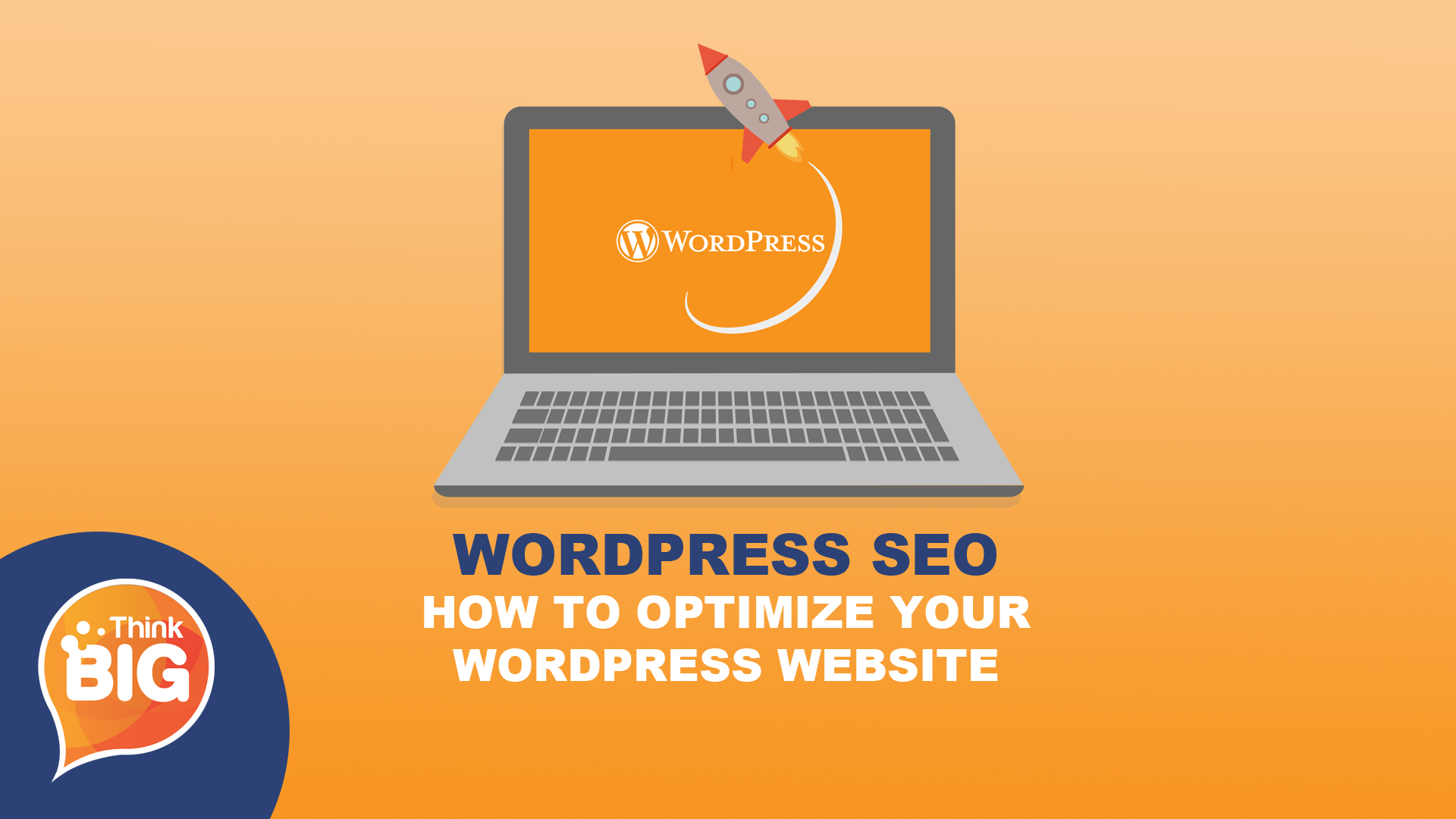
In general, WordPress SEO has two sides – one technical and another branding side. The final goal is to offer a quality site which contains great content that will help you rank higher in search engines and, in turn, get more traffic.
And in order to do this, you need to know the basics of WordPress SEO optimization.
In this article, we’re sharing some of the simplest and most effective SEO tips that will help you stay ahead of your competition.

#1 www or non-www?
If you’re just starting a WordPress site, the first dilemma you’ll face is whether you should include www in your domain.
The answer is, from an SEO perspective, including www in the domain is of no use, i.e. it won’t get you better rankings. Whether you decide to include it or not depends on personal preference.
However, whichever version you decide to go with, it is wise to set up redirects in order to easily access each version of the website.
Furthermore, you can choose how you want your site to appear in search results by setting up your preferred version (www or non-www) in Google Search Console.
#2 Make Your URLs Short
Having a short URL contributes to your WordPress site’s structure and organization, which is something search engines like.
In addition, short URLs are one of the factors that can improve your click-through-rate.
When you add the content, WordPress automatically creates a URL based on the title. And if it seems too long, you can shorten the URL by simply clicking on the ‘Edit’ button in the visual editor (right under the title). Don’t forget to use hyphens between the words and click OK to save the changes.
Another important thing to remember that every post must have its own unique URL so be careful not to use the same URL in two or more posts.
#3 SEO Plugins
Even though WordPress is quite good as is in terms of SEO, installing an SEO plugin is always recommendable since it enables you to control everything that Google sees on your site.
The best WordPress SEO plugins are Yoast SEO and All-In-One SEO. The former is especially popular with more than a million installs and a five-star rating from users.
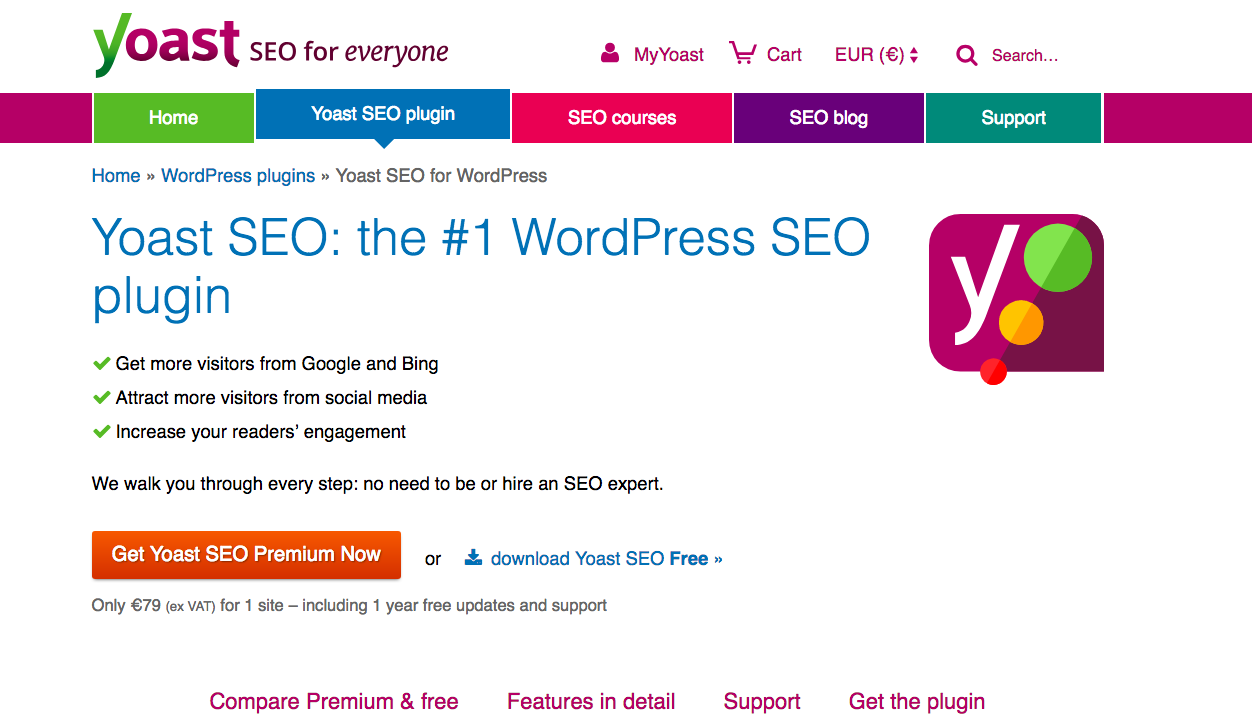
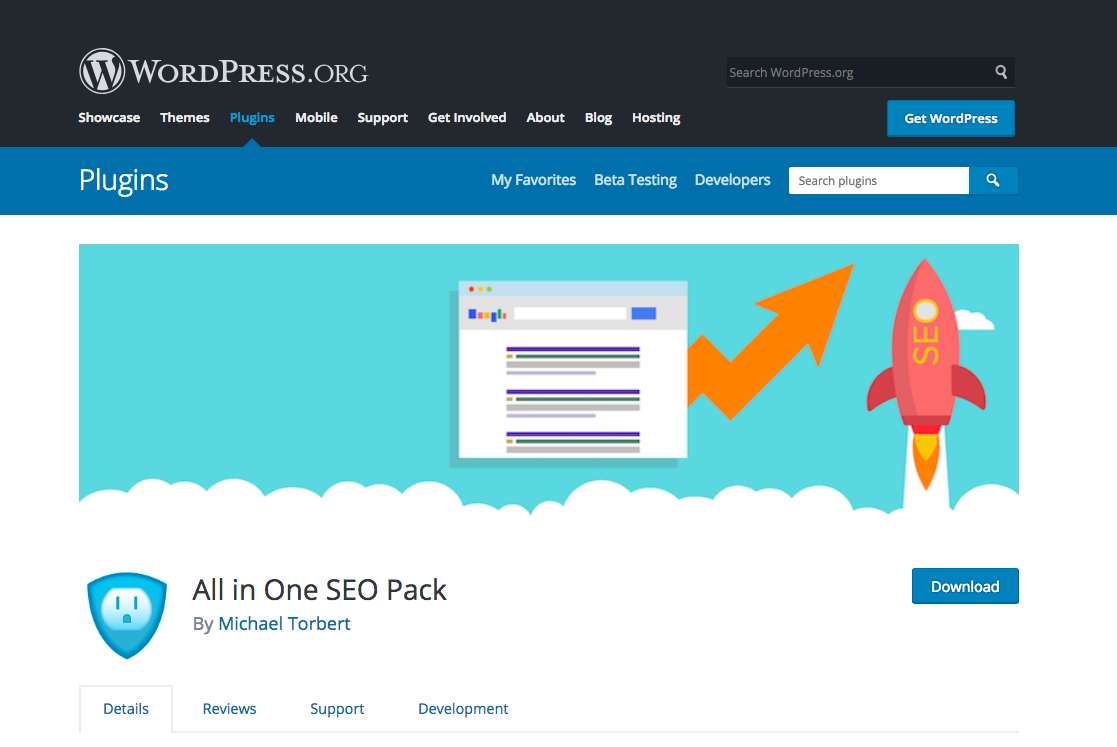
#4 The Importance of Focus Keywords
Keywords remain a crucial WordPress SEO optimization element. Even though Google recommends creating content primarily for real-life users, you should also optimize that content for search engines.
The best way to do this is by setting a focus keyword in every post. This is easily done with the Yoast plugin – once you enter the focus keyword, the plugin automatically analyzes its density and reports back, thus making your job a lot easier.
In general, any keyword density between 1% and 2% is good and you should be aiming to achieve it in every post.
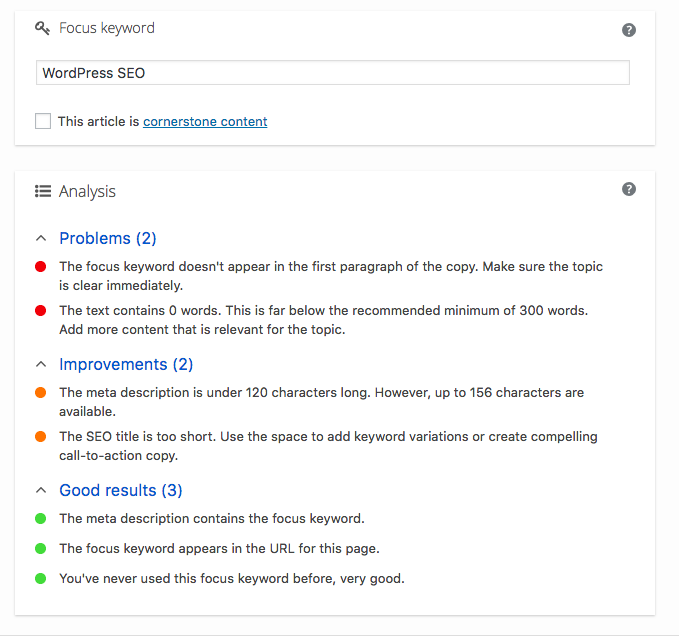
If you look at the screenshot, the plugin suggests adding the focus keyword in the first paragraph in order to make the topic clear to readers right away.
The first paragraph is also important SEO-wise since search engines start crawling the content from the top down. If they see the keyword at the very beginning, search engines will immediately determine that your content is relevant to the topic.
#5 Title Tags and Meta Descriptions
Title tags
The selected focus keyword you’re ranking for should appear in the page’s title tag. If possible, it should be placed at the title’s beginning for an additional SEO boost.
Yoast SEO is helpful for this as well since it allows you to set up title tags manually. Don’t forget that Google allows up to 65 characters in a title tag so anything above that number will not appear.
In addition to affecting SEO, the title tag can also increase your CTR (click-through-rate) by as much as 20%!
Meta descriptions
However, there’s another element that affects CTR even more – meta descriptions. A great meta description doesn’t influence your rankings but can make the user click on your link.
Well, actually, that’s not entirely true. The higher your click-through-rate is, the more authoritative and relevant you are to search engines and, as a result, you’ll rank higher.
Like the title tags, meta descriptions can also be set in the Yoast plugin. In 2017, the character limit was updated from 156 to 320.
Note: If you add the focus keyword in the description, Google will mark it in bold, thus helping you stand out.
#6 Header Tags
Header tags (H1, H2, H3, H4…) are important because they let search engine crawlers know that your website content is relevant. In addition, headers are used to split blocks of content and improve its readability for the users.
Note: You can check your content’s readability in Yoast. The plugin analyzes the text immediately after you add it and offers a list of problems and solutions for you to improve its readability.
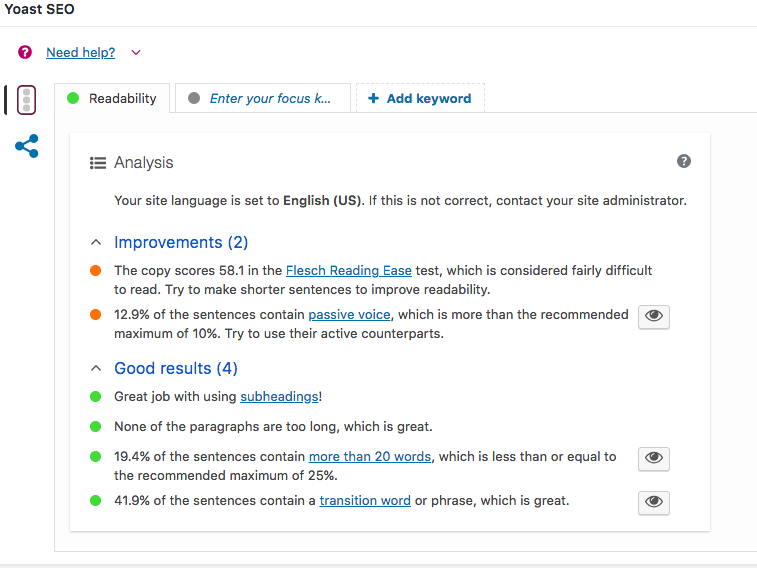
In general, each post (or page) should have one H1 tag which contains the focus keyword, and several H2 and H3 tags. These additional header tags can either contain the focus keyword or its long-tail varieties.
If you code your WordPress site properly, it will automatically mark the post’s title as H1 header tag. Then, you can set the other header tags using the drop-down menu in the WordPress visual editor.
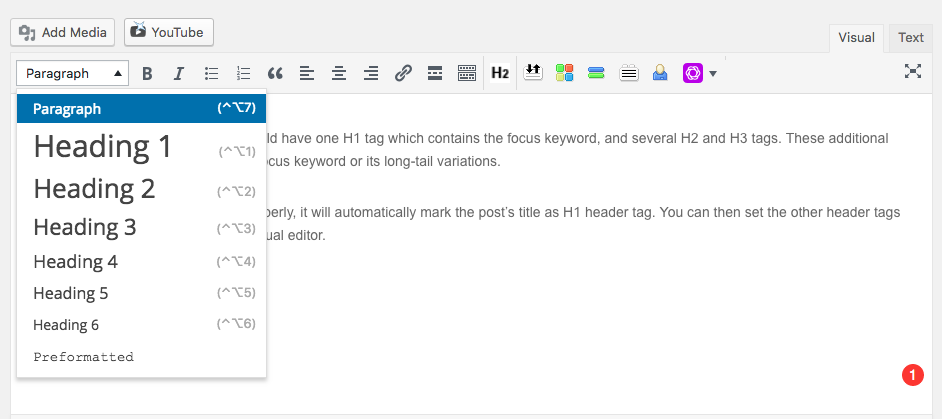
#7 Image Optimization
Images are optimized for SEO by applying ALT text (i.e. alternative text) and title text.
ALT text
The ALT tags tell Google that the picture is relevant to your content and that’s why you need to make sure all your images have it.
You can add your ALT text when uploading the image via the media library. Alternatively, you can simply click on the image in the WordPress visual editor, then hover over it and select ‘Edit’ to make the desired changes.
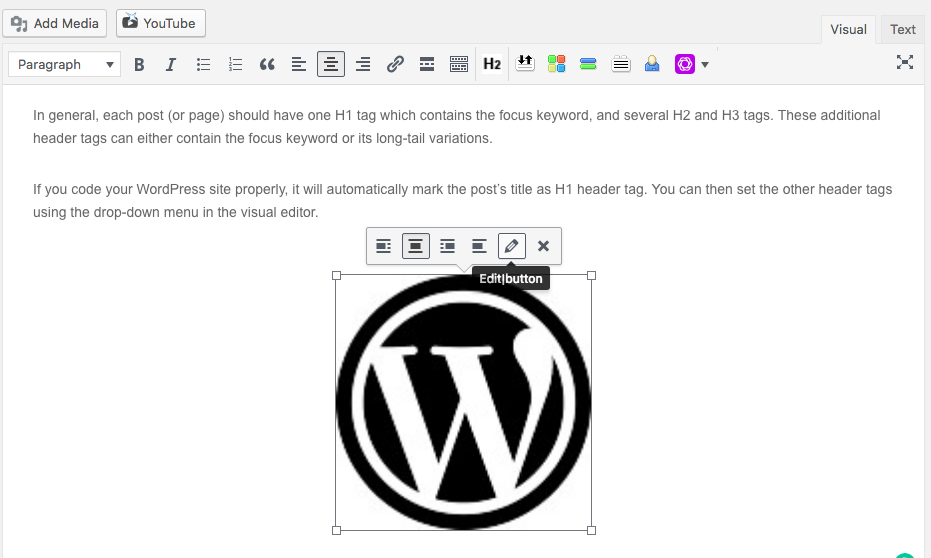
Then just add the ALT text in the field marked as ‘Alternative Text’. Whenever possible, try to include the focus keyword in your ALT text. However, be careful to use the focus keyword moderately. If you add it to all your images, search engines may see your page or post as spammy.

Title text
Just like the ALT text, the Image title text is simple to add when uploading the images via the media library or when editing the image in the WordPress visual editor. Just click the image and select the ‘Edit’ button, then go to ‘Advanced Options’ and fill the ‘Image Title Attribute’ section (see the screenshot above).
But unlike the ALT text, the Image title text has no SEO value, i.e. search engines don’t take it into consideration when ranking your site.
However, a title tag can help improve the user experience; for instance, you can add a call-to-action which users will be able to see when they hover over the image.
#8 Add Long, Evergreen Content
Content length
Both the search engines and the users like high-quality, original content. And as far as search engines are concerned, the longer the content the better.
SEO experts like Neil Patel agree that, in order to improve your rankings, it’s better to post articles longer than 2000 words.
A study published by SerpIQ confirms this stating that “higher ranked sites have more content.”
In addition to boosting your rankings, long content allows you to rank for a number of long-tail keyword variations in addition to the focus keyword, which can significantly increase organic traffic.
Evergreen content
By definition, evergreen content is content that is always relevant. Evergreen content has many advantages. For instance, it can be shared repeatedly and used to keep building backlinks.
However, bear in mind that evergreen content has to be updated from time to time in order to keep up with the changes in your industry and stay relevant.
#9 Internal Links
Internal links are links that point from one page to another (or one post to another) on your website.
These interlinks are important for several reasons:
- They allow visitors to navigate your site and find what they want more easily, thus increasing the time they spend on your site.
- They contribute to better structure and hierarchy of information on the site.
- They’re dofollow so they help spread the link juice throughout the website.
SEO experts recommend adding about five interlinks on each page or post. If the content is longer, this number can increase.
To add an internal link, highlight the word or phrase and then select the link button in the visual editor.
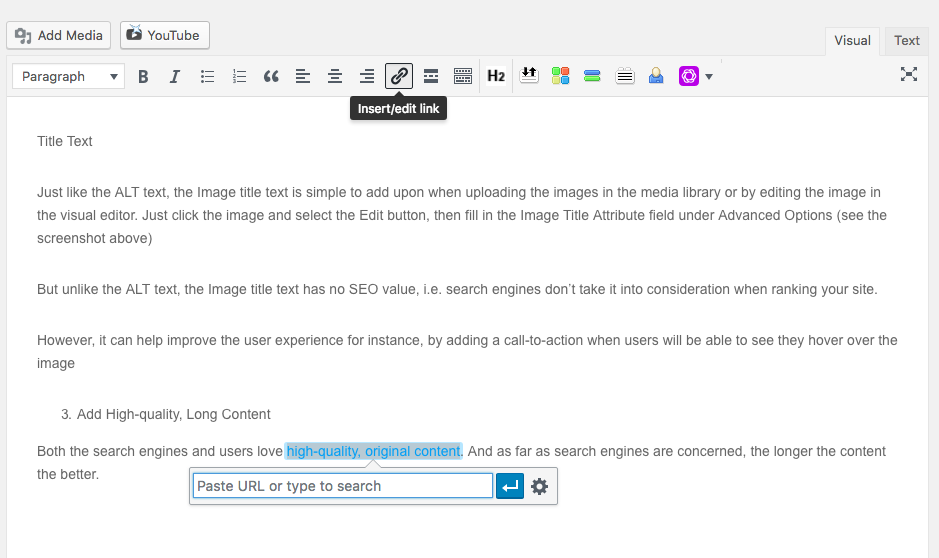
Next, you can simply add the URL of the page or the post you want to link to or select ‘Link options’ and choose a recent article from the suggested list.
#10 External Links
In addition to adding internal links, you also need to add external links. External links to authority websites tell Google that your content is relevant to the high-quality content published on these sites. In addition, it provides readers with extra information, thus improving user experience.
When it comes to the number of external links per page or post, SEO experts say that you should add at least two.
Note: When adding external links, make them open in a new window or tab in order to prevent visitors from leaving your website.
Conclusion
When it comes to WordPress SEO optimization, these 10 tactics are just the tip of the iceberg. There’s so much more you can do – set friendly permalinks, add affiliate links, make use of social signals, add schema markup, etc.
WordPress SEO can definitely be overwhelming, but this checklist will hopefully help you start off the right way.
Which important WordPress SEO tips would you like to see included? Let us know in the comments.

